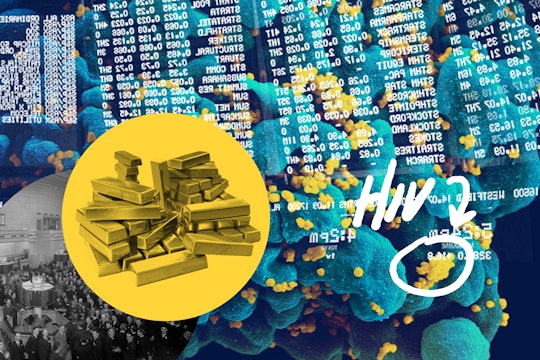

Produced in partnership with NPR Scicommers
Can scientists learn from the stock market to eradicate HIV?
HIV is tricky to fight because the virus changes so much. That reminded researchers of something else that fluctuates frequently.
Scientists have been trying for decades to develop an HIV vaccine. But the virus changes so fast that it's hard to design a treatment that can keep up with it. That property has a group of scientists trying something new by drawing inspiration from a different hard-to-predict structure: the stock market. If the approach shows promise, it could bring us one step closer to finally stopping and eliminating the disease.
Fast-moving virus
According to the World Health Organization, more than 70 million people worldwide have been infected with HIV since the epidemic officially began in 1981. To date, about 35 million people have died of HIV and another 36.7 million infected people are still living today. Millions of dollars have poured into HIV research, and scientists have developed antiviral drugs that make the disease more manageable. So far, however, no effective vaccine exists.
“Like Polio, we hope to one day eradicate HIV and AIDS. However, one of the major problems with HIV vaccine design is the diversity of the highly dynamic virus,” says Hiffel Haim, of the University of Iowa.
HIV is a deadly message encased in a protective envelope. On the surface of the envelope is a coat of spiky structures called Env proteins. The virus works by first docking on host cells using these punctuating spines, and then later infecting them. That mechanism is fairly straightforward, but there's a catch: the surface proteins are the part of the virus that changes rapidly. That's a big problem for anyone trying to develop treatments, because Env proteins are the only target for vaccines on the surface of HIV molecules.

A diagram of the HIV virus, showing the spiky Env proteins on the surface.
Illustration by Thomas Splettstoesser via Wikimedia Commons
“Compared to other viruses, the diversity of HIV is staggering. Two samples collected from the same exact HIV-affected individual at the same time are at least 10 percent different in the composition of their Env proteins,” Haim said.
Because the HIV virus mutates so quickly, there are many different types of the virus out there, making designing a catch-all vaccine incredibly difficult.
“To make a vaccine that will continue to match the virus over time, vaccine makers need to know what Env variants are currently circulating in the patient population and also be able to predict how these proteins will change,” Haim said.
Market-based solutions
That's where the stock market comes in. While the stock market is complex, we've been able to build models that examine the structure and change in a stock's price over time and predict its future prices, with varying levels of success. These models typically consist of a long-term representation of the stock market over time, and make use of a concept called volatility.
In the stock market, volatility is a measure of how much a stock's price tends to fluctuate over time. Individual stocks often have a characteristic volatility, almost like a signature, which allows us to predict how they'll move over time. Like stocks, the amount of fluctuation in individual properties of the HIV virus seems to be characteristic. For some properties, the fluctuation is characteristically small, and for others, the fluctuation is large.
.jpg)
Scanning electron micrograph image of HIV virions attached to the surface of a lymphocyte.
Photo by C. Goldsmith via Wikimedia Commons
That's the similarity Haim explored in his new study, which took the same tools used to predict stock prices and applied them to one of the world's largest banks of HIV blood samples, collected by Jack Stapleton, one of Haim's colleagues at the University of Iowa. Haim and his team found that measures of volatility from HIV patients in the 1980s can be used to accurately predict how different properties of HIV Env proteins evolved in the population of Iowa in the course of 30 years.
Interestingly, stock price prediction models might be even better at predicting viruses than they are at forecasting the very thing they were designed to predict. Financial models can’t seem to account for everything that happens in the stock market, since random, day-to-day events on the global scale can have small to large effects on the market.
“Compared to stock prices, fewer elements affect HIV and its evolution in an individual and a population. It’s so much more predictable, and the predictions of changes in HIV that we have shown are so much more accurate,” Haim said.
Predicting the future of the vaccine
Haim’s study provides a framework for other computational biologists to build on. And Haim hopes his work can apply beyond HIV, including improving the design of seasonal flu vaccines.
But there's still plenty to be done. While mathematical models can predict the evolution of HIV properties over time, additional work will be needed to translate the predicted properties into a preventative vaccine. We have to create structures from the predicted HIV properties, and see if introducing them to the human body in small amounts helps build the body's immune response. While we’ll have to wait for this exciting continuation, we’re one step closer to eradicating HIV/AIDS.
